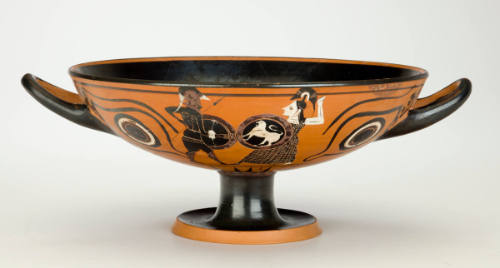Worcester Art Museum returns Antiquities to Italy

The Worcester Art Museum (WAM) announced today that it has entered into a long-term loan agreement with the Italian Ministry of Culture as part of the Museum’s voluntary return of two objects from its collection.
In 2024, the Museum hired its first Provenance Research Specialist to identify provenance gaps and conduct new research into its collections. As a result of this work, the Museum identified two antiquities acquired in the mid-1950s—a black-figure amphora (storage jar) and a kylix (drinking cup)—that appeared to have been unlawfully removed from Italy. The Museum promptly notified the Italian Ministry of Culture, which confirmed through its database that it considered the objects to have been stolen. Under the terms of a new cultural cooperation agreement, the Museum has transferred ownership of the two objects to Italy but will keep them as loans from the Italian Republic for a period of four to eight years. After this loan period, these objects will be returned to Italy in exchange for a loan of comparable antiquities from Italian museums. The loans will recur on a rotating basis. This is the first such agreement of its kind for WAM.
This project is part of the Worcester Art Museum’s ongoing provenance work, performed by Daniel W. Healey, WAM’s inaugural Provenance Research Specialist, under the leadership of Claire Whitner, the Museum’s Director of Curatorial Affairs and James A. Welu Curator of European Art. Hired in early 2024, Healey is responsible for researching the provenance of antiquities and other artworks in the Museum’s collections, advising on acquisitions, loans, and deaccessions, and developing new ways of sharing the histories of WAM’s collections with the public.
“We are deeply grateful to the Italian Ministry of Culture for their collaboration, which will enable the Worcester Art Museum to regularly showcase new antiquities for visitors in Central Massachusetts,” said Whitner. “This partnership, initiated and fostered by Daniel Healey’s excellent research, highlights the value of having dedicated expertise on our staff to uncover the histories of objects in our collections. Provenance research is vital to ethical collecting, and we look forward to continuing this work.”
Dr. Paolo D’Angeli, Head of the department of General Affairs of the Italian Ministry of Culture, commented: “The Worcester Art Museum has demonstrated commendable ethical integrity by engaging its specialists in research on the origins of the Institute’s collections, with the clear understanding that the findings could potentially indicate illicit provenance.”
“The Ministry of Culture can only express its utmost appreciation for the Museum’s voluntary decision to return to Italy two finely crafted archaeological artefacts of Attic production. This gesture marks the beginning of an agreement that will engage the Museum and the Italian Ministry of Culture in a fruitful policy of loans and cultural exchanges that will contribute to raising awareness of the issue of illicit art trafficking.”
Dr. Paolo D’Angeli added that “the role of the Carabinieri Command for the Protection of Cultural Heritage of the Italian Ministry of Culture was once again pivotal in the realization of the restitution and collaboration agreement.”
The amphora is attributed to the Rycroft Painter, an Athenian vase-painter active in the last decades of the 6th century BCE. On one side of the black-figure vase is a chariot scene featuring Hermes, Leto, and her divine twins, Apollo and Artemis. The other side depicts the wine god Dionysos and a retinue of satyrs and dancing Maenads. The kylix, created in the 5th century BCE, features twin scenes of Athena battling a giant, framed by pairs of large eyes. Although the Museum acquired both vases in 1956 from the art historian and dealer Elie Borowski, provenance research traced both objects back to Robert Hecht. An American-born dealer based in Paris, Hecht is now known to have traded in looted antiquities from Turkey and Italy.
Main Image: Black-figure amphora (storage jar), attributed to the Rycroft Painter, about 515-500 BCE.
